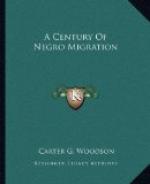[Footnote 1: Locke, Anti-Slavery, pp. 19, 20, 23; Works of John Woolman, pp. 58, 73; and Moore, Notes on Slavery in Massachusetts, p. 71.]
[Footnote 2: Bassett, Federalist System, chap. xii. Hart, Slavery and Abolition, pp. 153, 154.]
[Footnote 3: Turner, The Rise of the New West, pp. 45, 46, 47, 48, 49; Hammond, Cotton Industry, chaps. i and ii; Scherer, Cotton as a World Power, pp. 168, 175.]
[Footnote 4: Locke, Anti-Slavery, chaps. i and ii.]
[Footnote 5: Jay, An Inquiry, p. 30.]
[Footnote 6: Ford edition, Jefferson’s Writings, III, p. 432.]
[Footnote 7: For the passage of this ordinance three reasons have been given: Slavery then prior to the invention of the cotton gin was considered a necessary evil in the South. The expected monopoly of the tobacco and indigo cultivation in the South would be promoted by excluding Negroes from the Northwest Territory and thus preventing its cultivation there. Dr. Cutler’s influence aided by Mr. Grayson of Virginia was of much assistance. The philanthropic idea was not so prominent as men have thought.—Dunn, Indiana, p. 212.]
[Footnote 8: Ibid., p. 254.]
[Footnote 9: Code Noir.]
[Footnote 10: Speaking of these settlements in 1750, M. Viner, a Jesuit Missionary to the Indians, said: “We have here Whites, Negroes, and Indians, to say nothing of cross-breeds—There are five French villages and three villages of the natives within a space of twenty-one leagues—In the five French villages there are perhaps eleven hundred whites, three hundred blacks, and some sixty red slaves or savages.” Unlike the condition of the slaves in Lower Louisiana where the rigid enforcement of the Slave Code made their lives almost intolerable, the slaves of the Northwest Territory were for many reasons much more fortunate. In the first place, subject to the control of a mayor-commandant appointed by the Governor of New Orleans, the early dwellers in this territory managed their plantations about as they pleased. Moreover, as there were few planters who owned as many as three or four Negroes, slavery in the Northwest Territory did not get far beyond the patriarchal stage. Slaves were usually well fed. The relations between master and slave




